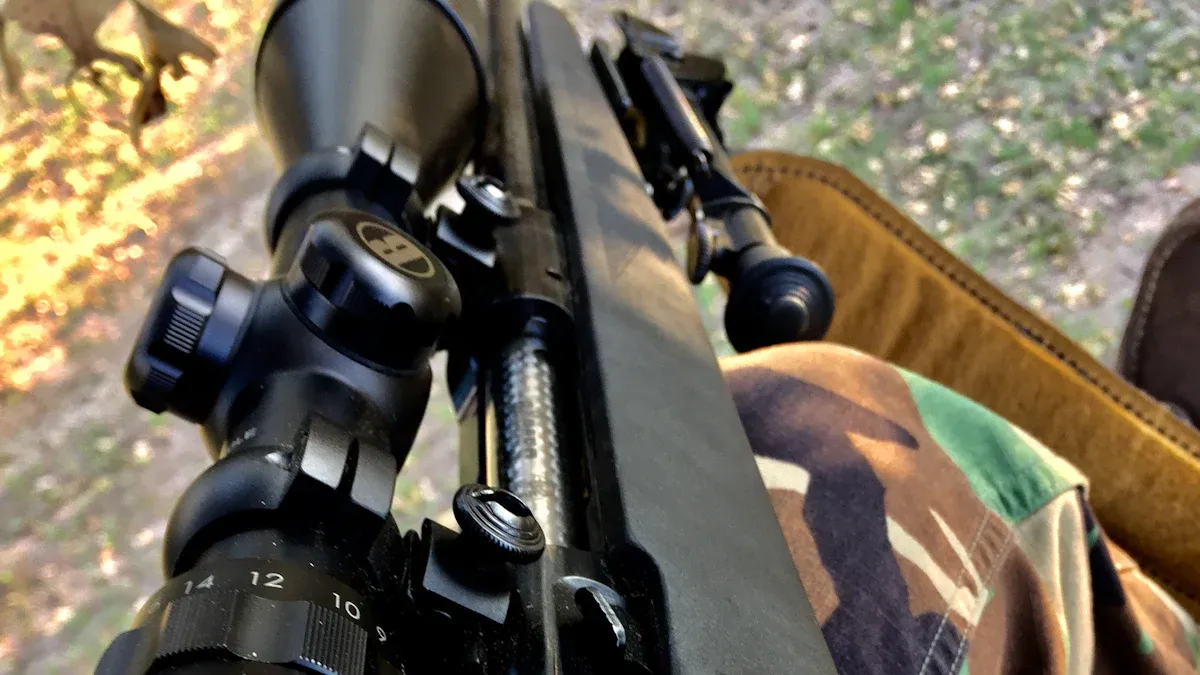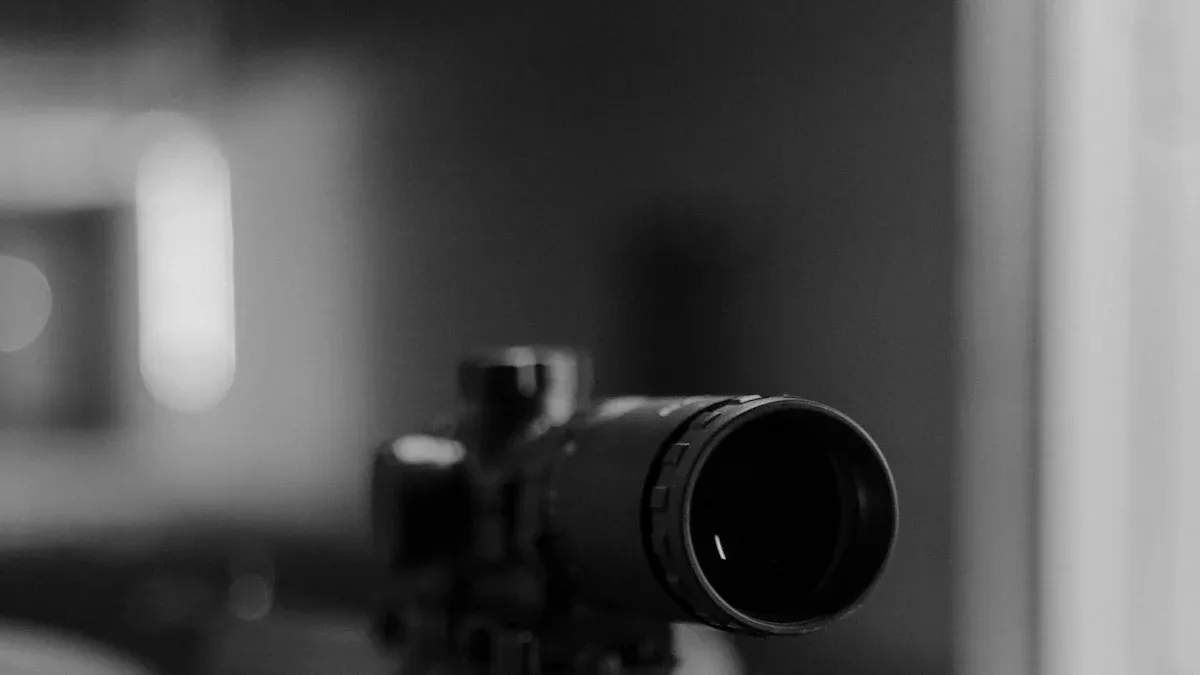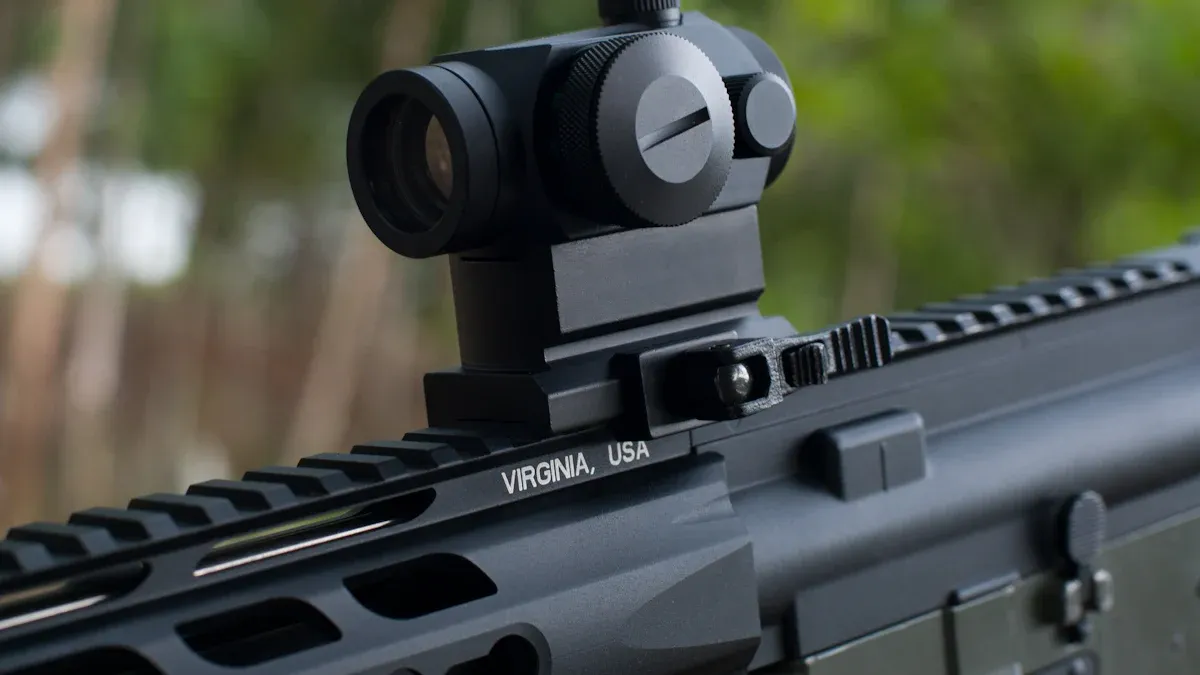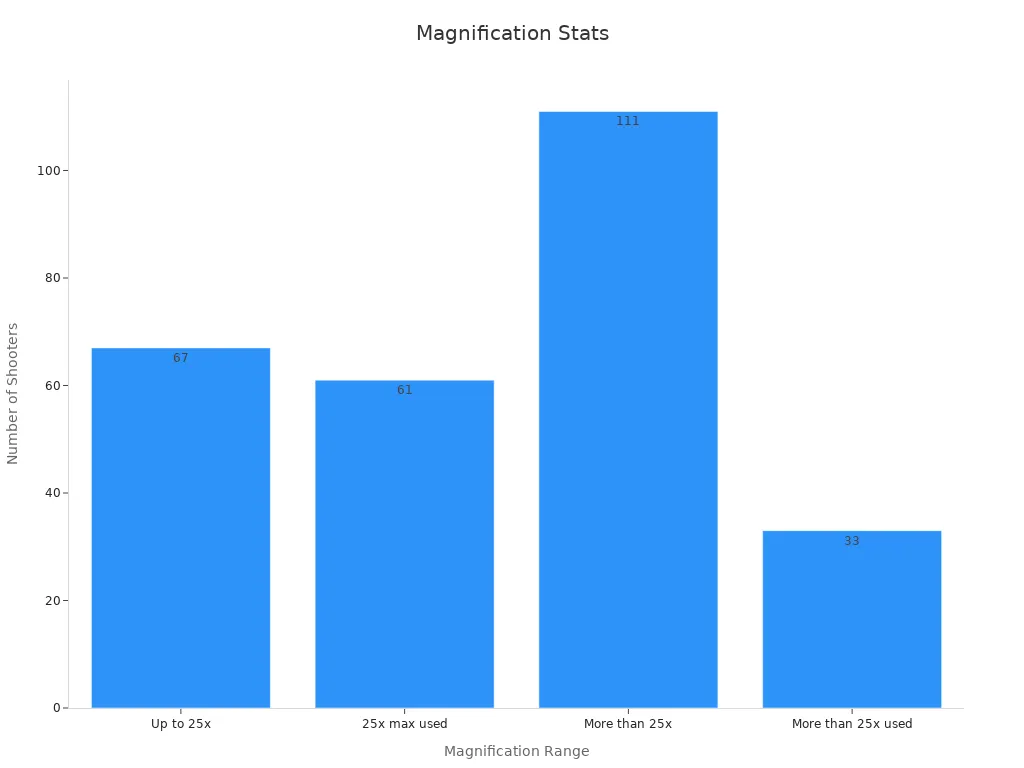
Choosing the right rifle scope can transform your shooting experience. Magnification numbers determine how much closer your target appears, making small game or distant targets easier to spot. For example:
- Close-range shooting (under 100 yards) works best with 1x–4x magnification.
- Long-range shots (300+ yards) demand 8x–16x or higher.
Key Takeaways
- Pick the right zoom level for your shooting range. Use 1x–4x for short distances (less than 100 yards) and 8x–16x for far distances (over 300 yards).
- Think about fixed or adjustable zoom scopes. Fixed scopes are easy to use, but adjustable ones work for many situations.
- Try scopes before buying them. Check how they work in real-life settings to make sure they fit your shooting needs.
Understanding Rifle Scope Magnification

What Magnification Numbers Represent
Magnification numbers on a rifle scope indicate how much closer a target appears compared to the naked eye. For example, a 3x magnification makes the target look three times larger. Lower magnifications, such as 1x to 4x, are ideal for close-range shooting, while higher magnifications, like 9x to 12x, excel at distances over 200 yards. Extremely high magnifications, such as 13x to 24x, are best for long-range precision shooting in open spaces.
However, higher magnification does not always guarantee better accuracy. In tests, shooters using 4x magnification often achieved tighter groupings than those using 16x. Lower magnification can improve stability and focus, especially for moving targets.
Fixed vs. Variable Magnification
Rifle scopes come in two main types: fixed and variable magnification. Fixed scopes offer a single magnification level, such as 8.5×50, making them simple and reliable. Variable scopes, like 3.5-21x, allow users to adjust magnification based on their needs.
Variable scopes provide flexibility for different shooting scenarios. For instance, a hunter can use lower magnification for scanning and higher magnification for precise shots. Fixed scopes, on the other hand, are often preferred for their simplicity and consistent performance at specific ranges.
| Type | Magnification Range | Objective Lens Diameter | Example Specification |
|---|---|---|---|
| Fixed Magnification | Single value | Specific size | 8.5×50 |
| Variable Magnification | Range of values | Specific size | 3.5-21× |
Popular Magnification Ranges and Their Applications
Different magnification ranges suit various shooting activities:
- Medium Magnification (5x – 9x): Balances detail and field of view, making it ideal for hunting and recreational shooting at 100-300 yards.
- High Magnification (10x – 20x+): Designed for long-range precision, this range is essential for competitive shooting and varmint hunting.
Many competitive shooters prefer scopes like the Razor® HD Gen II 4.5-27×56. Interestingly, they rarely use magnifications above 18x, as mid-range settings often provide the best balance of clarity and performance.
Choosing Magnification for Different Shooting Scenarios

Short-Range Shooting (Under 100 Yards)
For short-range shooting, a rifle scope with low magnification (1x–4x) is ideal. This range provides a wide field of view, allowing shooters to quickly acquire moving targets. It’s particularly useful for activities like brush hunting or close-quarters defense. Scopes designed for this range often feature capped turrets and second-plane reticles, ensuring simplicity and reliability.
Tip: A scope with a parallax setting fixed at 100 yards enhances accuracy for short-range shots.
| Metric | Rating |
|---|---|
| Optical Performance | Good |
| Mechanical Performance | Very good |
| Design | Good |
| Price/Value | Very good |
Mid-Range Shooting (100-300 Yards)
Mid-range shooting benefits from versatile magnification levels, typically 4x–8x. This range balances clarity and stability, making it suitable for deer hunting in open fields or varmint hunting. Scopes with 3-9x or 4-16x magnification are popular choices, as they provide flexibility for different targets.
For instance, a 4x magnification offers a stable view for moving targets, while 8x allows for precise aiming at stationary objects. Higher magnifications, though available, can make aiming more challenging due to increased sensitivity to movement.
| Shooting Activity | Typical Distance | Recommended Magnification Range |
|---|---|---|
| Varmint hunting/target shooting | Up to 300 yards | Versatile (4x – 8x) |
| Deer hunting (open fields) | Up to 300 yards | Versatile (4x – 8x) |
Long-Range Shooting (300+ Yards)
Long-range shooting demands higher magnification, typically 8x–16x or more. These scopes enhance the shooter’s ability to identify and hit distant targets. For competitive shooters, magnifications of 10x–25x are often sufficient, even though some scopes offer up to 35x.

Note: While high magnification provides greater detail, it narrows the field of view and may reduce stability. Many experienced shooters prefer mid-range settings for better balance.
Hunting vs. Target Shooting
Hunting and target shooting require different magnification considerations. Hunters often favor versatile scopes (3x–9x) for adaptability in varying environments. In contrast, target shooters may opt for higher magnifications (10x–20x) to achieve precision over long distances.
| Magnification Type | Benefits | Drawbacks |
|---|---|---|
| Higher Magnification | Greater detail for long-range shots | Narrower field of view, potential stability issues |
| Fixed Magnification | Brighter, clearer image | Limited flexibility in magnification levels |
Fixed scopes, with fewer lenses, often deliver brighter and clearer images, making them a popular choice for hunters. Variable scopes, however, provide the flexibility needed for competitive shooting.
Key Factors Beyond Magnification
Field of View
Field of view (FOV) determines how much of the scene a shooter can see through the scope. It becomes narrower as magnification increases, which can impact target acquisition. For example, a low-magnification scope offers a wider FOV, making it ideal for tracking moving targets or scanning large areas. Conversely, high magnification narrows the FOV, which is better suited for precise long-range shots. Shooters must balance magnification and FOV based on their specific needs.
Image Quality and Lens Coatings
A rifle scope’s optical quality depends on factors like resolution, light transmission, and lens coatings. High-quality lenses, precisely cut and assembled, ensure bright and clear images. Lens coatings reduce glare and improve light transmission, enhancing visibility in various conditions. For instance, premium scopes like the Vortex Razor HD Gen III excel in clarity, even at maximum magnification, making them a top choice for competitive shooters.
Performance in Low-Light Conditions
Low-light performance is critical for hunting at dawn or dusk. Most modern scopes transmit 85% to 95% of light, but differences below 2% are often imperceptible to the human eye. Scopes with superior light transmission and larger objective lenses perform better in dim conditions, providing a brighter image. Shooters should prioritize these features when selecting a scope for low-light environments.
Scope Weight and Portability
Scope weight affects portability and ease of use. Lightweight scopes are easier to carry and handle, especially during long hunting trips. However, heavier scopes often include advanced features like larger lenses or higher magnification. Shooters must weigh the benefits of added functionality against the potential strain of carrying a heavier scope.
Practical Tips for Selecting the Right Rifle Scope
Evaluate Your Shooting Environment
Understanding your shooting environment is crucial when selecting a rifle scope. Factors like terrain, weather, and lighting conditions can significantly impact performance. For instance, tools like the Kestrel 5700 with Hornady 4DOF provide real-time environmental data, helping shooters calculate windage corrections and long-range holdovers. This eliminates guesswork and ensures precision.
Hunters in dense forests benefit from low-magnification scopes with wide fields of view, while those in open plains may require higher magnifications for distant targets. Additionally, consider how wind, temperature, and humidity affect bullet trajectory. A scope tailored to your environment enhances accuracy and reliability.
Match Magnification to Your Rifle and Ammunition
Pairing the right magnification with your rifle and ammunition ensures optimal performance. A versatile 3-9x40mm scope suits most rifles, balancing magnification and ease of use. Larger objective lenses improve light transmission, making them ideal for low-light conditions. However, heavy recoil rifles demand scopes with adequate eye relief, typically 3.5–4 inches, to prevent injury.
Reticle options also play a role. Duplex reticles work well for general use, while BDC and Mil-Dot reticles cater to long-range and tactical shooting. Matching these features to your rifle and ammunition guarantees a seamless shooting experience.
Test Scopes Before Committing
Testing a scope before purchase is essential. Evaluate its accuracy by analyzing shot impact points relative to adjustments. Consistent tracking ensures that adjustments correspond to impact points within 1-2% accuracy. Check parallax settings for clarity and test the scope under various lighting conditions.
Visiting a range or consulting with experts allows you to assess the scope’s performance firsthand. This step prevents costly mistakes and ensures the scope meets your specific needs.
Avoid Common Mistakes
Many shooters overlook critical factors when choosing a rifle scope. Insufficient eye relief can lead to discomfort or injury, especially with high-recoil firearms. Parallax adjustments are often ignored, resulting in blurry images and missed shots.
Understanding the scope’s intended use is equally important. A scope designed for hunting may not perform well in competitive shooting. Durable construction and proper sealing are vital for withstanding harsh environments. Investing in a quality scope that matches your rifle’s value prevents these common pitfalls.
Selecting the right rifle scope magnification enhances shooting accuracy and overall performance. Studies show that rifle stability and aiming accuracy explain 81% of shooting score variance, with stability alone accounting for 54%. Shooters should also consider field of view, lens quality, and light conditions for optimal results.
“That depends, but I find myself a lot of times shooting a match on 16x magnification. If there is a target that is washed out or in the shade and it’s hard to see the edges, I might bump up to 20x on that stage. But typically, I don’t run over 18x or under 12x.” – Austin Orgain, 2-Time PRS Champion
Take time to test scopes and evaluate their performance in real-world conditions. A well-chosen scope ensures precision and elevates the shooting experience.
FAQ
What magnification is best for beginners?
Beginners should start with a 3-9x scope. This range offers versatility for short to mid-range shooting and helps build confidence without overwhelming complexity.
Does higher magnification always improve accuracy?
No, higher magnification narrows the field of view and reduces stability. Mid-range magnification often provides better balance for most shooting scenarios.
How do I maintain my rifle scope?
Clean lenses with a microfiber cloth and store the scope in a dry, padded case. Regularly check for loose screws to ensure consistent performance.
Tip: Investing in a lens cleaning kit protects your scope from scratches and extends its lifespan.
Post time: Apr-14-2025
